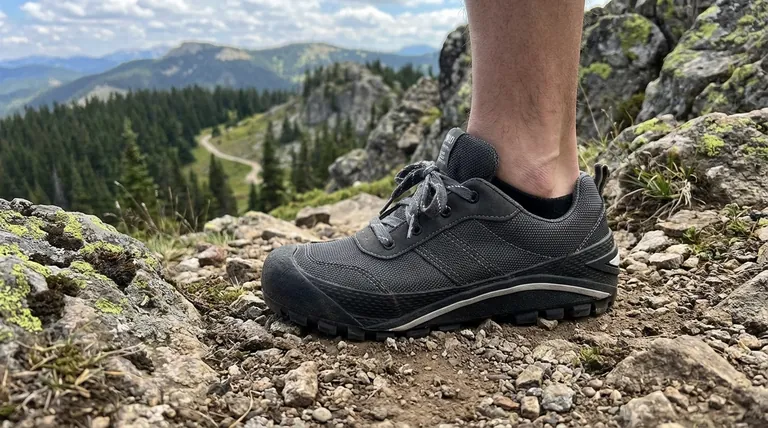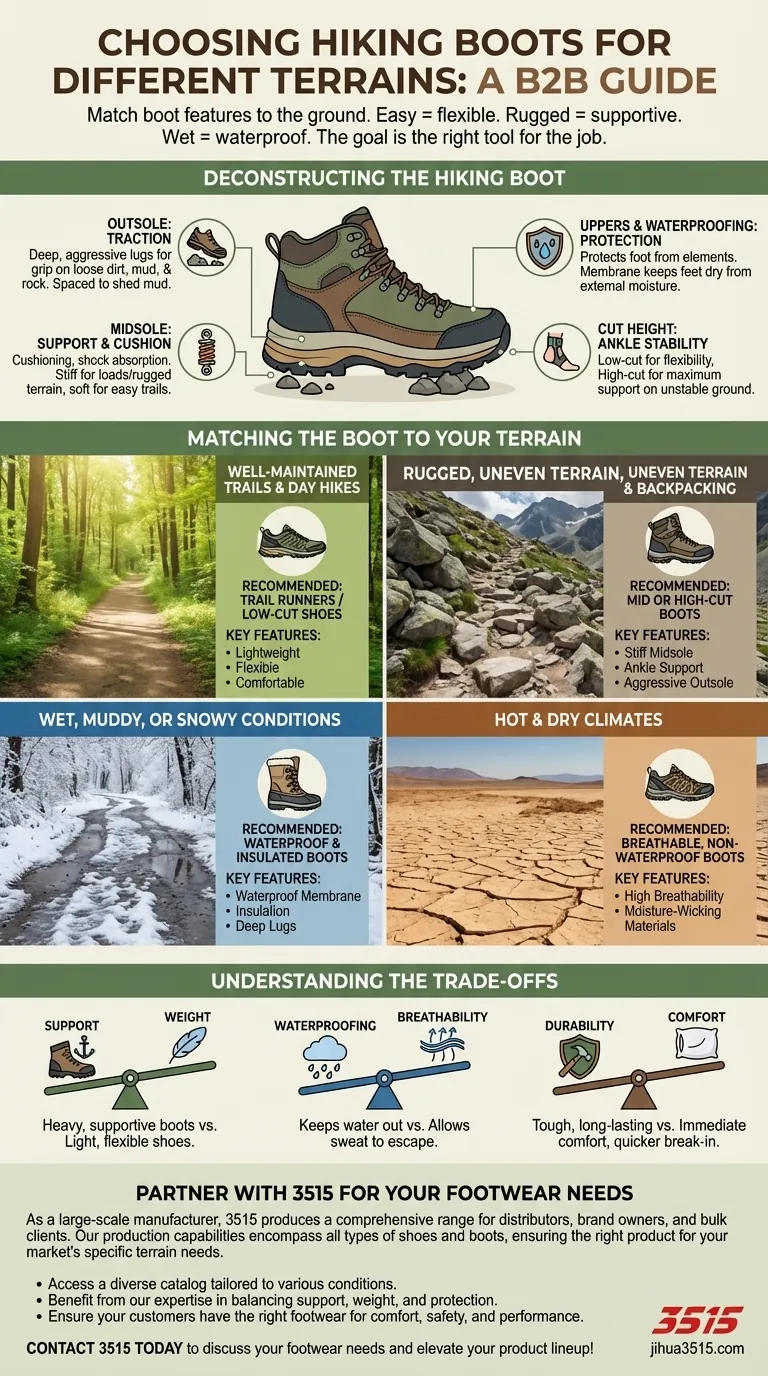The short answer is you match the boot's features to the ground you'll be covering. For easy, well-maintained trails, choose lightweight and flexible hiking shoes or trail runners. For rugged, uneven, or off-trail terrain, you need the superior support and protection of sturdier mid or high-cut hiking boots with aggressive outsoles. For consistently wet or snowy conditions, waterproof and insulated boots are non-negotiable.
The goal isn't to find one "perfect" boot for all conditions, but to understand the fundamental trade-offs between support, weight, and protection. Choosing the right boot means selecting the right tool for the specific job your hike demands.

Deconstructing the Hiking Boot
To make an informed decision, you must first understand the core components of any hiking footwear and the function each one serves. The terrain dictates which of these components you need to prioritize.
The Outsole: Your Connection to the Ground
The outsole is the rubber bottom of your boot that makes contact with the trail. Its primary job is traction.
Look for deep, aggressive lugs (the bumps on the outsole) for grip on loose dirt, mud, and uneven rock. A more widely spaced lug pattern helps shed mud more effectively.
The Midsole: Cushioning and Support
The midsole provides cushioning, absorbs shock, and determines the boot's stiffness. This is critical for comfort and stability, especially when carrying a pack.
Stiffer boots provide more support on rocky, uneven terrain, preventing your feet from fatiguing. Softer, more flexible boots are more comfortable for easy, flat trails.
Uppers & Waterproofing: Your Shield from the Elements
The upper part of the boot protects your foot from rocks, roots, and weather. Materials range from lightweight synthetics to durable full-grain leather.
Many boots include a waterproof membrane (like Gore-Tex) to keep your feet dry from external moisture like rain, puddles, or stream crossings.
Cut Height: Ankle Stability
The height of the boot—low, mid, or high-cut—directly relates to ankle support.
Low-cut shoes offer the most flexibility but the least support. High-cut boots provide maximum ankle support, which is crucial on unstable terrain or when carrying a heavy backpack.
Matching the Boot to Your Terrain
With an understanding of the components, you can now intelligently match a boot to your intended environment.
For Well-Maintained Trails & Day Hikes
On smooth, predictable trails, your priorities are low weight and comfort.
Choose trail runners or low-cut hiking shoes. Their flexibility allows your foot to move naturally and their light weight reduces overall fatigue on long mileage days.
For Rugged, Uneven Terrain & Backpacking
When the trail becomes steep, rocky, and unpredictable, or when you're carrying a heavy pack, your priorities shift to support and protection.
Select mid or high-cut boots with a stiffer midsole. The added ankle support helps prevent sprains, and the rigid sole protects your feet from sharp rocks underfoot.
For Wet, Muddy, or Snowy Conditions
Dealing with moisture is a primary concern in these environments to prevent blisters and maintain comfort.
A waterproof boot is essential. For winter hiking, you must also choose an insulated boot with thick outsoles specifically designed for traction on snow and ice.
For Hot & Dry Climates
In hot environments, your biggest enemy is internal moisture: sweat.
Consider highly breathable, non-waterproof boots or shoes. While it seems counterintuitive, they allow sweat to evaporate far more effectively, keeping your feet drier and less prone to blisters than a waterproof boot would.
Understanding the Trade-offs
Every boot design is a compromise. Being an expert means knowing what you're gaining and what you're giving up with any choice.
Support vs. Weight
A heavy, supportive backpacking boot is excellent for protecting your feet and ankles under a heavy load on rough terrain. However, that same boot feels clunky and energy-sapping on a simple day hike. Remember the old saying: a pound on your feet is like five on your back.
Waterproofing vs. Breathability
A waterproof membrane is fantastic for keeping rain and stream water out. However, it also traps sweat vapor inside the boot. In hot weather, this can lead to your feet getting soaked from the inside out, causing blisters and discomfort.
Durability vs. Comfort
Tough, full-grain leather boots can last for years and offer incredible protection. But they are often heavier and require a longer "break-in" period than lighter, synthetic models. Modern synthetic boots are often comfortable right out of the box but may not withstand the same level of long-term abuse.
Making the Right Choice for Your Hike
Your boot choice should be a direct reflection of your primary hiking goal.
- If your primary focus is speed and comfort on easy trails: Choose lightweight trail runners or low-cut hiking shoes for maximum flexibility and minimal fatigue.
- If your primary focus is stability and protection while backpacking: Choose mid-to-high-cut boots with a stiff sole to support your ankles and shield your feet.
- If your primary focus is all-weather versatility for varied terrain: Choose a mid-cut, waterproof hiking boot as a reliable all-around option that balances support and protection.
- If your primary focus is winter safety and warmth: Choose a dedicated insulated, waterproof, high-cut boot designed for traction on snow and ice.
Ultimately, the right boot is the one that makes you forget you're even wearing it, allowing you to focus on the experience of the hike itself.
Summary Table:
| Terrain Type | Recommended Boot Type | Key Features to Look For |
|---|---|---|
| Well-Maintained Trails & Day Hikes | Trail Runners / Low-Cut Hiking Shoes | Lightweight, flexible, comfortable |
| Rugged, Uneven Terrain & Backpacking | Mid or High-Cut Boots | Stiff midsole, ankle support, aggressive outsole |
| Wet, Muddy, or Snowy Conditions | Waterproof & Insulated Boots | Waterproof membrane, insulation, deep lugs |
| Hot & Dry Climates | Breathable, Non-Waterproof Boots | High breathability, moisture-wicking materials |
Ready to equip your customers with the perfect hiking boots for any adventure?
As a large-scale manufacturer, 3515 produces a comprehensive range of footwear for distributors, brand owners, and bulk clients. Our production capabilities encompass all types of shoes and boots, ensuring you get the right product for your target market's specific terrain needs—from lightweight trail runners to durable, waterproof backpacking boots.
Partner with us to:
- Access a diverse catalog tailored to various hiking conditions.
- Benefit from our expertise in balancing support, weight, and protection.
- Ensure your customers have the right footwear for comfort, safety, and performance on any trail.
Contact 3515 today to discuss your footwear needs and elevate your product lineup!
Visual Guide

Related Products
- Durable Rubber Sole Outdoor Shoes Wholesale & Custom Manufacturing
- Safety Footwear Wholesale Manufacturer for Custom OEM/ODM Production
- Durable Waterproof Rain Boots | Custom Manufacturer for Wholesale & Brands
- Premium Wholesale Waterproof Safety Boots High Performance Protection for Industrial Markets
- Premium Insulated Safety Boots and Shoes for Wholesale & Bulk Orders
People Also Ask
- What are the characteristics of heavy-duty hiking boots? Ultimate Guide for Rugged Terrain
- How does cushioning work in hiking shoes? The Science of Shock Absorption
- What are some alternatives to hunting boots? Hiking, Rubber & Tactical Boots Explained
- What should be considered when choosing hiking boots for snake protection? Prioritize Fit & Materials for Safety
- What are the main applications of vulcanized rubber? Unlock Durability for Tires, Footwear & More



















